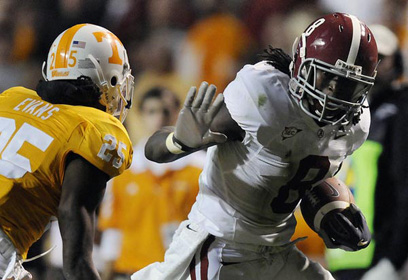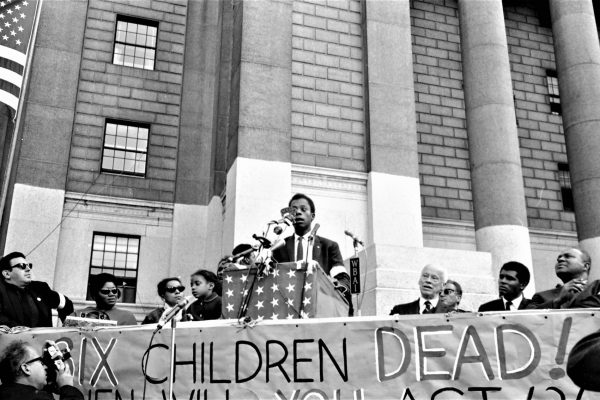“GET YOUR MIND RIGHT! HOOO!!! GET YOUR MIND RIGHT! HOOO!!! GET YOUR MIND RIGHT! HOOO!!!”
It is an overture that will soon echo in stadium tunnels throughout the NCAA’s Southeastern Conference whenever the University of Alabama Crimson Tide storm onto the football field. It is quintessential jock talk, but also a statement of what Coach Nick Saban calls “the process,” the challenge, he told 60 Minutes, “to play every play in the game like it had a history and life of its own.” In turn, wins and losses take care of themselves. Since Saban arrived in Tuscaloosa in 2007, the Crimson Tide have won three national championships and more than 80 percent of their games.
Though many have accused Saban of being a maniacal dictator with an unhealthy addiction to winning, nobody can doubt his iconic status in America’s sporting landscape. What is more, he is one of the highest-paid employees in American higher education. When CBS’s Armen Keteyian asked Alabama Chancellor Robert Witt whether Saban’s annual compensation—currently $7.1 million not including incentives and private endorsements—is justified, Witt responded, “Nick Saban is the best financial investment this university has ever made.”
Saban is not just well paid: he is adored. Fans flock like pilgrims to his bronze statue in front of Alabama’s Bryant-Denny Stadium. Together, the statue and stadium have become the institutional and symbolic center of a nonprofit organization ostensibly dedicated to intellectual growth and the social good.
The university is becoming an engine for the production of profits rather than a safe harbor in which to think and learn.
The ascent of the college athletics business has occurred at a time when higher education is increasingly viewed as little more than a means to enhance social and economic status. While elite sports programs (particularly football and men’s basketball) have created a professional culture of athletic specialization and promotion, universities such as Stanford and MIT have followed a similar trend in academic research, funneling talent and patent licenses into corporations in exchange for ample short and long-term rewards. All of this speaks to a reconfiguration of the university as an engine for the production of profits rather than a safe harbor in which to think and to learn both skills and the ethos of democratic participation.
In a number of recent books—such as Martha Nussbaum’s Not For Profit: Why Democracy Needs the Humanities (2010), Andrew Delbanco’s College: What it Was, Is and Should Be (2012), Benjamin Ginsberg’s The Fall of the Faculty: The Rise of the All-Administrative University and Why It Matters (2011), and William Deresiewicz’s Excellent Sheep: The Miseducation of the American Elite and the Way to a Meaningful Life (2014)—we see clearly how the new emphasis on career, and future earnings, is eroding the cultivation of critical thought and the moral formation needed to instill values of democratic citizenship. In the United States, athletics have traditionally played an important role in that formation, for both players and spectators. But, as Murray Sperber argues in Beer and Circus: How Big-time College Sports Is Crippling Undergraduate Education (2000), academics and athletics have been tainted by the same transformation: from nonprofit arenas of qualitative enrichment, to private, for-profit institutions justifying themselves on the basis of quantitative measures.
Citing former University of California president Clark Kerr’s prophetic words from the 1960s, Sperber shows how the quantitative and credential-based approach to higher education creates “a mad scramble for football stars and professorial luminaries.” According to Kerr, “The former do little studying and the latter little teaching, and so they form a neat combination of muscle and intellect.” While the marriage may give the appearance of a thriving campus, the result is “an inferior concern for undergraduate teaching” along with exaggeration of the prestige associated with academic credentials and winning teams.
Delbanco suggests that the quantitative approach Kerr warned against has come to undermine one of the distinct intellectual and moral advantages that colleges and universities have traditionally preserved: “Their deliberate distance from the world of getting and spending in which young people are destined to spend so much of their lives.” Instead, the commodification of higher education has placed the world of getting and spending—not intellectual or moral cultivation—at the heart of what both college and college sports are for. This is a critical change not only of conditions, but also of mores. As Deresiewicz recently wrote in Harpers,the result is an “ideology that reduces all values to money values. The worth of a thing is the price of the thing. The worth of a person is the wealth of the person.” Thus, the “purpose of education in a neoliberal age is to produce producers,” leading to the widely accepted belief that the education of elite student-athletes is secondary to their athletic performance and financial compensation.
The ultimate institutional and ethical costs of this realignment remain to be seen, but as Keteyian and Jeff Benedict report in The System: The Glory and Scandal of Big-Time College Football (2013), we know how high the financial expenses can be. Funding Alabama’s victories requires a “cutting edge, damn-the-costs” approach, bolstered by annual revenues approaching $100 million. In 2011–2012, base level expenses reached $36.9 million. Unsurprisingly, Saban sees himself “as the CEO of what he repeatedly referred to as ‘the organization.’”
His style was similar to that of a chief executive officer—polite but fast moving, his fifteen-hour days during the season meticulously organized to strip away what he liked to call ‘the clutter’ in his life. To wit, with the click of a garage-door-like remote Saban could automatically close his office door, saving precious steps and time; his master calendar was plotted out at least eighteen months in advance; meetings with academic advisers and coaches all but eliminated small talk in favor of a quiet, direct ‘What do we got?’
Elite college athletics is not the agent behind this shift in norms, though. It is merely symptomatic of institutional changes taking place throughout academia. As Terry Eagleton writes in The Chronicle of Higher Education, he resigned from Oxford University once it became obvious that he was expected to “behave less as a scholar than a CEO.” Subject to the whims of “vice chancellors who behave as though they are running General Motors,” Eagleton understood that he was being asked to produce quantifiable successes that humanistic pursuits such as history, philosophy, theology, art, and literature naturally resist. That is, unless one of these disciplines could act as “a service station for neocapitalism,” answering to the ambiguous demands of economic progress. “There has thus been less incentive for academics to devote themselves to their teaching, and plenty of reason for them to produce for production’s sake,” Eagleton writes, “churning out supremely pointless articles, starting up superfluous journals online, dutifully applying for outside research grants regardless of whether they really need them.”
Where English professors teach English at their own peril, coaches who dare to uphold academic or moral standards risk no less.
Compared to athletic programs and coaches that can, in select cases, rationalize exorbitant salaries and expenses by pointing to impressive rates of competitive or financial success, most academic departments, especially in the humanities, don’t fare well. According to Eagleton’s account, the humanities “must now support themselves mainly by the tuition fees they receive from their students, which means that smaller institutions that rely almost entirely on this source of income have been effectively privatized through the back door.” Thus, important aspects of human inquiry are no longer preserved because they don’t promise financial reward. The CEO scholar, like the CEO coach, must set aside the discipline he or she might otherwise favor, if it would endanger earnings. Eagleton writes:
As professors are transformed into managers, so students are converted into consumers. Universities fall over one another in an undignified scramble to secure their fees. Once such customers are safely within the gates, there is pressure on their professors not to fail them, and thus risk losing their fees. . . . One result of this hot pursuit of the student purse is the growth of courses tailored to whatever is currently in fashion among 20-year-olds. In my own discipline of English, that means vampires rather than Victorians, sexuality rather than Shelley, fanzines rather than Foucault, the contemporary world rather than the medieval one. It is thus that deep-seated political and economic forces come to shape syllabuses. Any English department that focused its energies on Anglo-Saxon literature or the 18th century would be cutting its own throat.
Where English professors teach English at their own peril, athletic departments and coaches who dare to uphold substantive academic or moral standards risk no less. And where self preservation in English means focusing on fanzines instead of Foucault, self-preservation in athletics means focusing on wins and losses, revenue, entertainment, and student entitlement instead of education.
Colleges often justify the obsession with athletic entertainments by pointing to the revenue and exposure it can provide for academics, but as Ginsberg points out, “Usually, whatever revenues are produced by sports programs flow back into the athletic department rather than the school’s general coffers.” In The System Benedict and Keteyian report, “Just 22 of the top 120 [Division I football teams] had turned a profit in 2010–11. The average institutional debt of the other 100 or so schools was approaching $11 million each.” And, according to Sperber, “Often athletic department fund-raisers compete with regular university development . . . officers for dollars from the same alum.” This despite the fact that athletic departments benefit from booster clubs, “fans who, unlike alumni, never attended the institution and whose interests in it focuses almost exclusively on its college sports teams.”
Not surprisingly, then, chancellors at football-crazed schools are always looking to expand their booster base, which requires investing enormous amounts of money to ensure that their coaches and teams keep fans and pilgrims in the seats. Thus, the marriage of muscle and intellect Kerr envisioned has devolved into an arms race for elite coaches, world-class training facilities, and blue-chip athletes paralleling the race for elite faculty, gaudy student centers, and highly credentialed students to fill them. As Sperber sees it, this arms race puts “college presidents and their assistants on fund-raising hamster wheels, engrossed in a never-ending search for dollars, primarily from the private sector.” All of which obstructs “long-range planning and attention to systemic problems, particularly undergraduate education.”
• • •
Echoing Albert Camus’s belief that the most profound ethical teaching he experienced was on the soccer field, theologian Stanley Hauwerwas has argued, “The most determinative moral formation most people have in our society is when they learn to play baseball, basketball, quilt, cook, or learn to lay bricks.” That college athletics (and academics) could support the intellectual and moral development of student-athletes, while enhancing the communal strength of campus life, is inarguable. But it is only a sustainable prospect if administrators and faculty at colleges and universities preserve the nonprofit values of higher education and treat athletics as more than a source of entertainment, revenue, and prestige.
To do so would demand a vision of athletic education that resists the temptation to profiteer at a time when college football’s popularity is soaring. Last season’s national championship game garnered the highest ratings in cable TV history, for a contest that featured Ohio State (whose starting quarterback Tweeted about his disregard for academic responsibility) and the University of Oregon (whose football players have an at-best middling graduation rate but enjoy a $68 million locker room paid for by Nike co-founder and Chairman Phil Knight). No amount of compromise or corruption has dissuaded fans and investors from tuning in—with eyeballs and cash. And when those investors include media conglomerates that attempt to do the work of journalism while promoting entertainment they profit from, there can be little hope that visible sports writers and commentators will take a more active role in reforming the current system. As theNew York Times reports, media outlets often have a vested interest in the status quo; ESPN, for example, has infused so many billions of dollars into college football that it has effectively become “both puppet-master and kingmaker, arranging games, setting schedules and bestowing the gift of nationwide exposure on its chosen universities, players and coaches.” In such a landscape, those who question the centrality of football in college life appear little more than tedious gadflies spoiling the tailgate.
But hearkening back to Socrates, it is always the gadfly whose mind will not endure glaring contradiction and therefore alerts the crowd to wisdom and truth.Whether he is embraced is another matter, as Brigham Young University football coach Bronco Mendenhall has found.
In 2003 BYU—a Mormon school with a strict honor code and a strong academic reputation—was coming off its third straight losing season, and university administrators were impatient. In a letter to Head Coach Gary Crowton, they made it clear that another losing season would be his last. So, he told Benedict and Keteyian, “I went out and recruited the best athletes,” which meant offering scholarships to a handful of players who had no understanding of or apparent interest in BYU’s academic mission or moral commitments. In 2004 four players were indicted on allegations of gang rape. As one would later say of the school’s honor code, “It was just a sheet of paper with everything else that we had to sign, some religious thing.” BYU went 5-6, and Crowton was fired.
Mendenhall soon took the job. On his first day as head coach, he recommitted BYU’s football program to a set of principles he deemed worthy of the school’s mission:
1. Help develop each BYU player spiritually.
2. Help each BYU player grow intellectually.
3. Develop character in each player.
4. Enable every player to provide public service.
5. Finish in the Top 25 every season.
Resisting the cynical assumption that elite college sports necessitates an ethos of moral and intellectual poverty, Mendenhall told Benedict and Keteyian, “I considered myself an employee of the institution. . . . I figured if those objectives applied to everyone that teaches and works at this university, they probably ought to apply to me, too.”
But, in spite of the fact that Mendenhall has steered BYU to an impressive 90-39 record while working to balance athletic ambition with academic achievement, he has not escaped criticism from fans and reporters who disapprove of his methods. After finishing 7-5 in 2012, Mendenhall received mocking treatment from the Deseret News. Winning football games was “only fifth on his priority list,” a columnist wrote amid taunts of “rest easy, Alabama.”
As we know, Alabama and their coach don’t rest a great deal. There is simply too much to lose in the collegiate arms race, where the worth of the thing is the price of thing; Alabama’s 2012 NFL draft picks signed for $52 million collectively. But financial gain isn’t supposed to be the only benefit universities and their athletic programs offer—or, at least, it wasn’t always. Today’s elite sports are just the starkest demonstration of the university’s new moral economy, which is rapidly redefining what it means to get our mind’s right.








